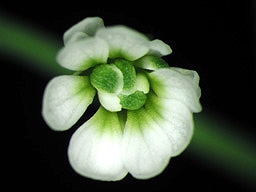NOVEL: Emergence of novel phenotypes in co-evolving biological systems: allelic diversification and dominance at the Self-incompatibility locus in Arabidopsis.

Project coordinator:
- Vincent Castric
Unité Evo-Eco-Paléo (EEP) - UMR 8198
CNRS / Université de Lille - Sciences et Technologies
Batiment SN2, bureau 207
59655 Villeneuve d'Ascq - FRANCE
Project partners:
- Isabelle Loisy - Thierry Gaude
Laboratory « Reproduction et Developpement des Plantes »
ENS Lyon CNRS - France
- Jacinthe Azevedo - Thierry Lagrange
Laboratory « Genome et Developpement des Plantes »
UMR 5096 (UPVD/CNRS) - Perpignan - France
Website:
http://eep.univ-lille.fr/fr/perso-vincent-castric
Abstract:
The emerging field of systems biology is revealing the intricate nature of biological organisms, whereby a large fraction of their individual components (genes, proteins, regulatory elements) interact with several others. The co-evolutionary processes that this entails raises the question of how phenotypic novelty may arise in the course of evolution, since all parts of the system have to evolve in a coordinated manner if the phenotype is to remain functional. For most biological systems, however, we are lacking even basic insight into the fine-scale mechanistic constraints and the underlying ecological context. In this project, we will focus on the sporophytic self-incompatibility system in outcrossing Arabidopsis species, a model biological system in which two distinct co-evolutionary processes are becoming well-understood: 1) between the male and female reproductive proteins allowing self-pollen recognition and rejection and 2) between small non-coding RNAs and their target sites that jointly control the dominance/recessivity interactions between self-incompatibility alleles. By studying these two model systems, we will aim to catch the emergence of functional and regulatory novelty in flagrante delicto. We will take a multidisciplinary approach combining theoretical and empirical population genetics, evolutionary genomics and ancestral protein resurrection using transgenic plants. Our goal is threefold: 1) decrypt the molecular alphabet of the interaction between co-evolving nucleotide sequences, 2) predict and evaluate the fitness landscapes upon which the two co-evolutionary processes are taking place and 3) exploit natural variation in closely related species to unveil the kind of co-evolutionary process in natural populations. Our combination of various powerful approaches in a tractable model system should provide insight on diversification, a poorly understood but fundamental evolutionary process that is taking place at all levels of organization.
This project is an extension of the project BRASSIDOM
| CNRGV's involvement: BAC library construction and screening
CNRGV's responsible: William Marande |
|
Publications related to the project:
The unusual S locus of Leavenworthia is composed of two sets of paralogous loci

